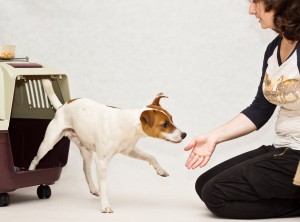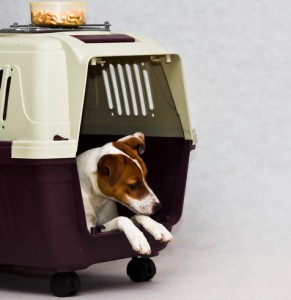How to make dog accustomed to cage
Article of Baskina Sofya. First published in magazine My Friend Dog # 10, 2011
Photo by Elena Ruzakova.
Translator Maxim Moroz.
There are three main reasons why dog may find herself in a cage: while traveling by car or plane, at dog events (exhibitions, competitions, etc.) and at home, where she is being sent, if she behaves badly in absence or even in presence of owner. The cage you will see on the photo, is suitable for two first situations. It is quite safe for both dog and freight handler. But such cage is not suitable as a home enclosure — it is too dark and oppressive for the dog. For home applications the cage of steel wire is acceptable. Anyway, remember that enclosure in apartment is just a temporary option, it’s not the place for dog to stay for most of the day or even — most of life.
Most of dogs are getting inside a cage calmly for the first time, but after finding that the owner is able to lock them inside, dogs are losing credence to a cage and that’s where problems begins. It is better to accustom the dog using items below and all problems with cage will be avoided.
The most common mistake in accustoming dog to a cage is an incorrect selection of cage dimensions. According to airlines websites, the cage ceiling shall be 10 cm above the dog head. On websites for cage sales, you can read that some specific cage is suitable for German shepherds, but in fact only Spaniel may stand freely in it. Measure your dog, or even better — “try” the cage in a pet shop. Home enclosure shall be at least two dog bodies long and one and a half wide. One part of the cage should be complete with a sleeping pad and in the other part a drinking bowl with fresh water should be provided.
 1) First you may remove the door from the cage. Get a dog inside with a treat. If the dog is in doubt — give her a treat only for putting inside her nose or one paw. Do not force the dog to get inside the cage. If your hand does not “pass” with a dog, it means that cage is too small.
1) First you may remove the door from the cage. Get a dog inside with a treat. If the dog is in doubt — give her a treat only for putting inside her nose or one paw. Do not force the dog to get inside the cage. If your hand does not “pass” with a dog, it means that cage is too small.
2) Right after the dog gets inside the cage — give her a treat, and then remove your arm from the cage and move over. Most likely the dog will jump out from the cage immediately. You can accompany this with “Come out!” words and, when she will get out — give a treat again. Then say: “Get to lodge!” and again take the dog inside the cage using a treat. Give a treat again and again — let the dog to jump out the cage. Repeat this sequence 10 times and then start giving a treat only if the dog is inside the cage.
3) Take your time, let the dog to get out from the cage as many times as she wants to, but every time she will get inside — give her a treat. If your dog already had a negative experience with a cage, this phase may take a few days of training. At some point, the dog will stand still and will remain inside the cage — make your dog again and again, all the time, until she stays in a cage. Then command “down!” and reward. Periodically remove your hands and check — shall the dog feels insecure — let her go out and get her inside again.
As soon as the dog will realize that she may obtain a treat and there is nothing she need to do for (except just staying in a cage), she will cease to jump out.
Dog’s trust to the cage is her independent decision to stay inside. Any violent actions ruins such trust and throw you back in accustoming progress.
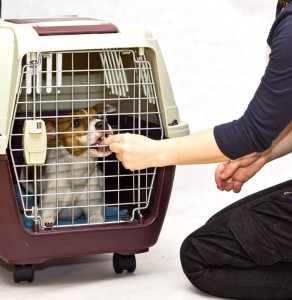 4) Now fit the door in the cage, get the dog inside, close the door, give your dog a treat, open the door and … did the dog jumped out? It means you need to repeat this procedure several times more. Did she left inside? Excellent — reward her properly, close the door again, reward and open again. Give a “Down!” command in order to accustom the dog to stay inside the cage in lay down position. Start to walk away from the cage with a few steps. Go back — give a treat, open the door and check — whether the dog will jump out or not. If she jumps out, it means that you hurry too much, you have to leave the dog for a less period of time, if she remains inside — she is comfortable with it.
4) Now fit the door in the cage, get the dog inside, close the door, give your dog a treat, open the door and … did the dog jumped out? It means you need to repeat this procedure several times more. Did she left inside? Excellent — reward her properly, close the door again, reward and open again. Give a “Down!” command in order to accustom the dog to stay inside the cage in lay down position. Start to walk away from the cage with a few steps. Go back — give a treat, open the door and check — whether the dog will jump out or not. If she jumps out, it means that you hurry too much, you have to leave the dog for a less period of time, if she remains inside — she is comfortable with it.
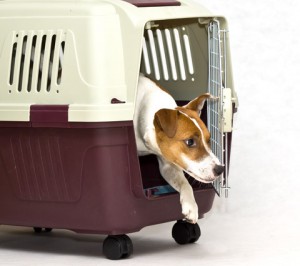 5) If the dog scratches the door with a paw or pushes it with a nose in an effort to open the door — do not prohibit her to do so. Did she managed to get out? Just get the dog back and reward her inside the cage, repeat accustoming steps 2 and 3. Is she scratches at the closed door? Give a “Down!” command and, as soon she will make it — reward her through the bars, open the door and let the dog out. And then get the dog in the cage again.
5) If the dog scratches the door with a paw or pushes it with a nose in an effort to open the door — do not prohibit her to do so. Did she managed to get out? Just get the dog back and reward her inside the cage, repeat accustoming steps 2 and 3. Is she scratches at the closed door? Give a “Down!” command and, as soon she will make it — reward her through the bars, open the door and let the dog out. And then get the dog in the cage again.
To make the dog ok with staying in the cage, she need to get inside it by her own will 100 times, but not to stay there for 100 minutes. In this case frequency is more important than duration.
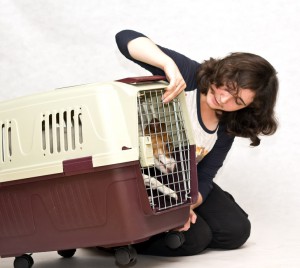 6) If the dog remains in the cage quietly, keeps laying without any jump-offs — congratulations! You made your pet accustomed already. You just need to make a few “final touches”. Roll the cage on wheels, shake it, raise and roll it for a few seconds. If the dog jumps of — put the cage on the floor, give a “Down!” command, reward your dog and let her out (if she wants). Then the dog inside again and try with cage shaking one more time. Give a dog a special reward if she will stay inside the cage after you open the door. Now you’re ready to go!
6) If the dog remains in the cage quietly, keeps laying without any jump-offs — congratulations! You made your pet accustomed already. You just need to make a few “final touches”. Roll the cage on wheels, shake it, raise and roll it for a few seconds. If the dog jumps of — put the cage on the floor, give a “Down!” command, reward your dog and let her out (if she wants). Then the dog inside again and try with cage shaking one more time. Give a dog a special reward if she will stay inside the cage after you open the door. Now you’re ready to go!

